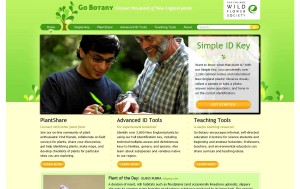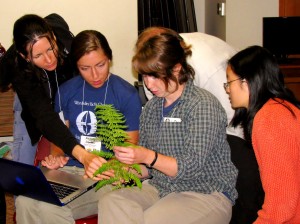Recently, Dr M discovered a botanical website called simply: “Go Botany“, based at the New England Wild Flower Society in the USA. This wonderful botanical site embraces botany in the 21st century with a whole suite of online teaching and learning tools, basic and advanced online keys, plant sharing and interaction with the botanical community young and old alike.
Dr M is delighted now to present this guest blog from Elizabeth Farnsworth, Senior Research Ecologist at New England Wild Flower Society and one of the creators and curators of “Go Botany”
Elizabeth writes:
“As Dr M’s marvelous website demonstrates, botanists are a lively and technologically savvy bunch, firmly taking root (as it were) in the 21st century to design next-generation tools for identifying and learning about plants.”
“For example, check out a new, free, convenient tool on your phone, tablet, or desktop computer: Go Botany“. Developed by the New England Wild Flower Society in Framingham, Massachusetts, USA, Go Botany is an interactive, on-line field guide that can help you learn about all of the native and naturalized plant species of New England (many of which, of course, hail from the UK, Europe, and elsewhere). It is a free website, built with funding from the US National Science Foundation, that anyone – from botanical beginners to professionals – can use.”
“New, ever-smaller technology allows you to get outdoors with your computer! Rather than lugging 60 pounds of field guide-books in your backpack, pack your tablet computer instead. When you next encounter an unfamiliar plant, take just minutes and a few key strokes to learn all about it. Here is how it works:
Imagine taking a walk in a nearby woodland. A lovely pink flower attracts your attention. You take out your iPad and link to the Go Botany website. First, figure out what broad group your plant is in: is it woody? No. Is it under water? No… You think it might be an orchid. Browse through some gorgeous photos and watch a brief video to learn more about orchids.
“Yes, eureka, your plant is an orchid! But which kind? Now, the program will prompt you to answer a handful of easy questions about your plant, such as “how many leaves does it produce?” and “where do they grow on the stem?”
“This is not just a random process of twenty-questions, though: using innovative technology, the dynamic Go Botany key asks you the questions about your plant that most efficiently home in on your species, based on the questions you have already answered and the features you tell the computer that you can see. Answer as few or as many questions as you can. Looking more closely, suddenly you notice all sorts of interesting features you had not seen before—hang on, those leaves are hairy!”
“You can view previews of all the candidate species as you narrow down your list of possibilities by the process of elimination. Choosing the closest match, you successfully identify your orchid and are magically transported to a richly illustrated page with lots of information about it. Here are colorful high-resolution photos and technical drawings, maps showing where your orchid lives in New England and North America, a memorable fact or two, and a list of all its characteristics, flowers, leaves, and all.”
“Tools for Teachers. Are you an educator looking for new ways to interest your students in learning about plants? Get the kids involved in creating a flora of your schoolyard! In testing Go Botany, we’ve seen first-hand how easily even young children catch on to how the program works with a little teacher guidance, using it to identify and learn plants that once just looked “all alike.” Go Botany keeps jargon to a minimum, and all terms are defined with a pop-up, illustrated glossary. Go Botany is designed to be user-friendly, yet informative enough to meet science teaching standards. Teachers can also post their curricula and modules in the Teaching Resources section of the Go Botany website.”
“Tools for Pros. If you are already a seasoned botanist, or perhaps a professor teaching students about plant science, you can use more advanced tools available through Go Botany. You have the option to use a clickable, technical, illustrated dichotomous key – based on the region’s most up-to-date and comprehensive guide, the Flora Novae Angliae by Arthur Haines (Yale University Press, 2011). You can easily navigate this key, track your choices, retrace your steps, and change your mind; no more flipping pages. Or, use our advanced version of the interactive Simple Key to identify some 3,500 species, subspecies, and varieties of plants.”
“Share and enjoy! At the PlantShare section of the Go Botany website, you can join a community of plant enthusiasts and share photographs and descriptions of species you have seen. Perhaps you are a volunteer for your local conservation organization, seeking to document the plants in a park. Use PlantShare to create a customized checklist of all the plants you encounter, complete with photos, geo-coordinates, and extra information. Our Expert Botanist can help you confirm your identifications. Go Botany also can be tailored to create identification keys for any region with a documented list of plants. For example, the Montshire Museum (Vermont), Chewonki Foundation (Maine), Yale Peabody Museum of Natural History (Connecticut) are all using Go Botany to develop on-line keys to their plants of interest. The US Smithsonian Institution has adapted Go Botany to create Go Orchids—a key to all the orchid species of North America (http://goorchids.northamericanorchidcenter.org/), and the Native Orchid Society of South Australia may soon follow suit.”
“Go Botany is the product of many hands working hard over the past five years, including the computing firm Jazkarta, smart programmers from Newfoundland to Los Angeles, seven botanical data specialists, four image collectors, a creative design team at Fresh Tilled Soil, a talented User-Experience designer (Matt Belge, VisionLogic), and many Society staff, interns, and volunteers who have starred in helpful videos, photographed plants, and beta-tested the web application. The software behind Go Botany is open-source and available for programmers to use and improve (contact gobotany@newenglandwild.org for more information). Hundreds of photographers have kindly donated more than 37,000 plant images and many other collaborators and advisors have tested, evaluated, and improved the website.”
“Next time you take a walk, computer in hand, you might look for that cool orchid you saw last time and know immediately what features to note. Before you know it, you’re hooked on the flora and take a little more joyous notice of the natural world. Technology does not have to alienate us from nature; it can get us genuinely “plugged in” to plants!”
Dr M says: Thanks to a bunch of dedicated botanists (and generous funding from US National Science Foundation) “Go Botany” has produced some really amazing tools for learning about plants for everyone! I love their philosophy and it’s a great botanical role model!
Featured image at the top of this post: Students at the Coop High School use Go Botany to identify invasive plants at East Rock Park in New Haven, Connecticut (image by James Sirch).
Other images:
1. Conservation volunteers use Go Botany to identify ferns (image by Dee Robbins).
2. The Go Botany landing page features tools for plant newbies, plant fans, plant pros, and plant science teachers. Come explore! (image by Fresh Tilled Soil).



